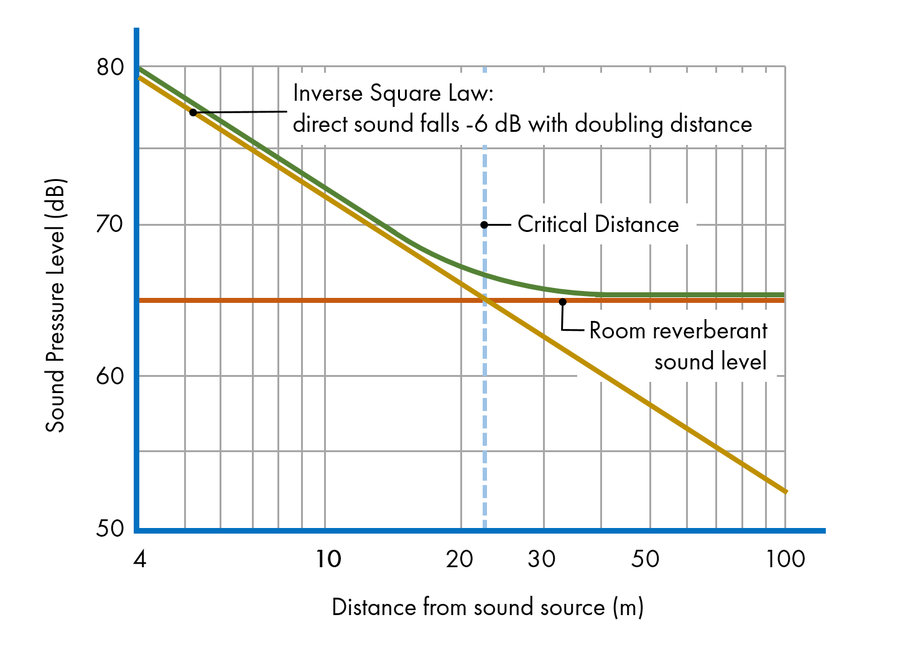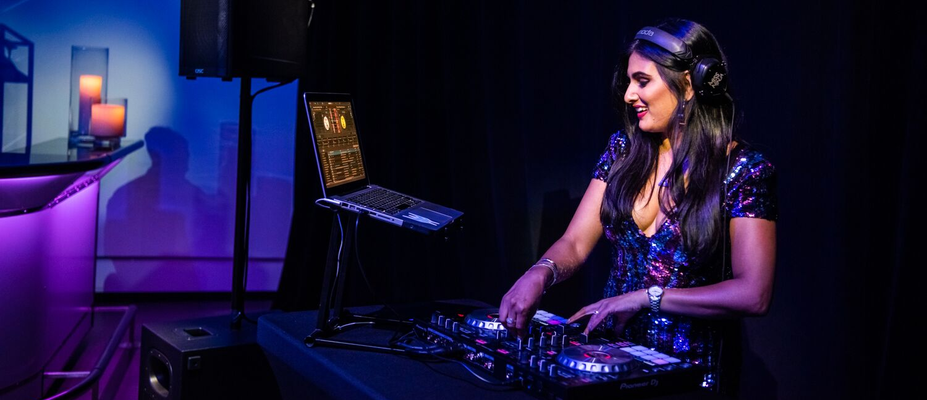There are a number of factors to consider when placing your loudspeakers to achieve optimal sound and performance. This four-part series aims to discuss a number of such challenges and to provide useful, practical tips to achieve great sound in any venue.
While part 1 discussed loudspeakers’ radiation spaces and associated bass boosts, as well as back wall cancellation phenomenon, this second part focuses on room acoustics challenges and discusses the ‘Inverse Square Law’ and the ‘Critical Distance’.
Consider Size and Room Acoustics
Let’s discuss room acoustics a bit. First, small venues are usually not appropriate for high sound level reproduction as they often exhibit strong, unpleasant midrange to low-mid resonances due to the room’s physical sizes matching such corresponding midrange wavelengths. In such rooms, try to avoid placing loudspeakers near corners, or half way between the floor and the ceiling. Additionally, make sure that the overall low frequency reproduction level is not overwhelming.
On the other hand, large venues will often exhibit strong reverberant field, which can lead to a loss in sound clarity and intelligibility, as well as muddy low frequency reproduction. In such venues, favor distributed sound systems across the room (such audio systems deliver audio to many loudspeakers rather than to just a few) in order to limit the excitation of the reverberant field, as much as possible.
Also, remember that low frequency sounds, which have very long, omnidirectional wavelengths, are powerful enough to make concrete slabs, walls and ceilings vibrate. Such structure-born vibrations are called ‘diaphragmatic resonances’, which often compromise the perceived low frequency definition. These resonances travel very efficiently via building structures and therefore, in most constructions, low frequencies can be heard – and/or felt – very far away from the PA system. If there is little you can do about this transmission phenomenon, be cautious of the level of low-end in your PA system, and consider if a cardioid subwoofer solution would be appropriate.
The term ‘cardioid’ refers to the heart-shaped coverage pattern of an audio device and in our case, a subwoofer. A cardioid subwoofer arrangement employs both front- and rear-firing transducers, and through some clever use of spacing, delay, and polarity, a cancellation of the rear-firing energy is created behind the subwoofer, while also enhancing the forward-firing energy. Looking at a single QSC KS212C or two KS118 active subwoofers placed together in cardioid mode, their radiation pattern measures 15 dB higher output at the front than at the rear. This desirable cancellation at the rear of the subwoofer can help to minimize the amount of low frequencies radiated behind the subwoofer, as well as reduce the energy that will potentially travel through the building structure.
Acoustically Reflective Surfaces
Room acoustics play a big role in the sound of a PA system. In general, it is rare to find rooms that are acoustically dead or heavily damped. On the contrary, it is rather common to find very reverberant venues, featuring large acoustically reflective surfaces that will project unwanted first reflections towards the audience and compromise the sound quality.
Therefore, before setting up your PA system, always carefully consider the direction and the type of wall surfaces the loudspeakers will be facing. Try to avoid large bay windows, glass surfaces, walls with stones or tiles, concrete surfaces, etc. Instead, try to set the PA system so that it faces walls that have furniture, shelves, sofas, curtains, draping, etc. The aim is to try to minimize (or partially absorb) the energy of the first reflections bouncing off the wall(s) directly opposite to the PA system.
Applying the Inverse Square Law
We should look now at how sound energy behaves over distance. The ’Inverse Square Law’ states that in a controlled indoor environment, direct sound will decrease in strength by 50 % (-6 dB) every time it doubles in distance from the source (see Figure 1). In a large venue, where the audience might be far away from the stage and the PA system, such level drop can be quite dramatic. This is why such venues commonly use delay or fill loudspeakers to complement the main PA system and make sure proper audience coverage is attained.
An interesting use of that law is the following one. Let’s define the closest point covered by each loudspeaker as your first distance, ‘a’, and the farthest point covered as, ‘b’. Now, if the goal of consistent audience coverage is to ensure that there is no more than a 6 dB difference between the loudest and quietest point in the audience, you will need to place and orientate your loudspeakers accordingly. The rule to follow is that, twice the distance ‘a’, should always be greater or equal to ‘b’ (2a ≥ b). Following this principle, we will look at how to implement this practically in our next article (Part 3).
The Critical Distance
Another interesting acoustic principle is the ‘Critical Distance’ that is defined as the distance from the sound source where the direct sound and reverberant sound energies become equal. To be precise, the reverberant sound field of a source is defined as that part of the sound field radiated by the source, which has experienced at least one reflection from a room boundary. If different surfaces have different ways of reflecting, absorbing and transmitting an incident sound wave, the more reverberant a room is, the closer the Critical Distance is to the sound source. Inversely, the more absorbent a room is, the further the Critical Distance is from the sound source.
For good room acoustic design, the Critical Distance should be as far as possible from the sound source and the resultant reverberation minimal and even at all frequencies. Direct sound from the loudspeaker decreases in level as a function of the distance (inverse square law), whereas reverberation constantly spreads throughout the room. Because there is new, incoming sound from the loudspeakers, reverberation keeps building up until the new incoming sound equals the sound absorbed.

When the reverberant sound becomes 12 dB, or greater, than the direct sound, all intelligibility is lost. One of the simplest way to locate this ‘Critical Distance’ is to play full spectrum music content through the sound system, and walk back and forth in the venue. You will be surprised how easy it is to identify this Critical Distance. You can repeat this exercise with multiple loudspeakers as well.
So, in any room where loudspeakers are used, such Critical Distance can be located. Therefore, if you can choose where the audience should be placed, always try to select the area, which corresponds to the direct sound field, before the location of the critical distance in the room. The audience located in the reverberant field of the room will likely perceive sounds with a compromised quality.
Conclusion
Having discussed how each loudspeaker interacts with neighboring surfaces and the space in which it radiates sound in part 1, as well as room acoustics challenges and how sound propagates over distance in part 2, our next articles will focus specifically on loudspeakers’ placement. All this with the aim of achieving optimal clarity and coverage in any venue and for the entire audience. Stay tuned!
Christophe Anet
Latest posts by Christophe Anet (see all)
- History, Development and Applications of Column Loudspeakers - May 30, 2025
- Why is Dynamic Range so important? - May 30, 2023
- Differences between Flown and Floor-Mounted Subwoofer Deployments - May 2, 2023
